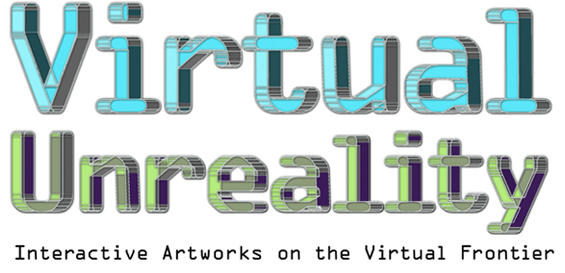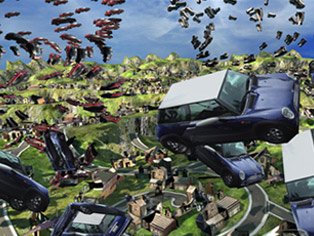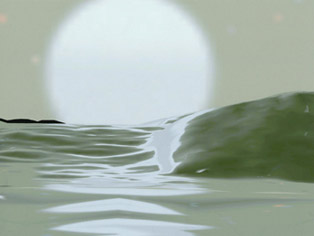|
|
|
|

|
|
|
Friday,
September 14 - Thursday, June 1, 2008
|
|
|
The artists in this exhibition embrace the inherently unreal nature of computer-generated environments to create landscapes and creatures that are subtly familiar, yet ultimately strange and otherworldly.
Their works compel us to consider the societal implications of our increasingly digital environments. Do they change the way we think? The way we feel? If you were to create your own virtual reality, what would it be?
—Pamela Winfrey, Curator
|

|
Scalable City
(2007), by
Sheldon Brown
, uses a data visualization pipeline to create an increasingly urbanized environment. Each step in the pipeline builds upon the last, amplifying exaggerations, artifacts, and the patterns of its algorithmic process. The resulting visions of rapidly created cultural objects provide equal measures of delight and foreboding. The project neither indicts nor embraces this possible future, but heightens our aesthetic awareness of the underlying logic determining much of our shared existence.
With assistance from Alex Dragulescu, Erik Hill, Mike Caloud, Joey Hammer, Carl Burton, & Daniel Tracy.
With support from High Moon Studios, Intel, IBM, Sun, The Center for Research in Computing and the Arts, & Calit2 at UCSD.
|
|
|
|

|
Life Spacies II
(1997–1999), by
Christa Sommerer
&
Laurent Mignonneau
, is an interactive artificial life environment that models a complex adaptive system. Users create artificial creatures by typing in messages. Text characters function as genetic code for the creatures’ designs; different texts create different creatures. Depending on their construction, creatures move quickly or slowly, trying to eat the same characters that make up their genetic codes. Once a creature has eaten enough characters, it looks for a mate. Offspring resemble both parents; their genetic code is the product of artificial evolution.
|
|
|
|

|
Ocean
(2000-2007), by
Dan Torop
, swells and subsides according to the laws of fluid dynamics. By expressing the elegance of certain physics- and mathematics-based models, the project becomes a practical experiment in the sublime: If the beauty of waves, reflected moonrise, and stars can be rendered by known formulae, is the experience still moving? Can technology and physics express—rather than explain away—the mysterious and the unknowable?
“There is an inherent melancholy in a mechanistic computer seeking to express the sublime through details. And there is something miraculous when such a mechanistic simulation compels the viewer.” —Dan Torop
|
|
|
|
About the Artists
Christa Sommerer
and
Laurent Mignonneau
are internationally renowned media artists and researchers. They have jointly created around 20 interactive artworks, which can be found at
www.interface.ufg.ac.at/christa-laurent
. These works have been shown in around 200 exhibitions worldwide and are installed in media museums and collections around the world. They have won major international media awards, including the 1994 “Golden Nica
”
Prix Ars Electronica Award for Interactive Art (Linz, Austria).
Mignonneau and Sommerer have published work on artificial life, complexity, interactivity, and interface design. They have lectured extensively at universities, international conferences, and symposia. After working for 10 years in Japan as researchers and professors at ATR Research Labs in Kyoto and IAMAS in Ogaki, they currently head the department for Interface Cultures at the University of Art and Design in Linz, Austria, which specializes in interactive art, interactive media, and interface design.
Sheldon Brown
is Director of the Center for Research in Computing and the Arts (CRCA) at the University of California at San Diego (UCSD), where he is a Professor of Visual Arts as well as Artist-in-Residence at the California Institute of Telecommunications and Information Technologies (Calit2).
His work examines the relationships between mediated and physical experiences, and often exists in a variety of public realms.
As an artist, he is concerned about overlapping and reconfiguring private and public spaces; how new forms of mediation proliferate co-existing public realms whose geographies and social organizations become ever more diverse. Art that explores schismatic junctions of these zones—the edges of their coherency—allows glimpses into their formative structures and suggests transformative modes of being, of extending constrained boundaries.
To see examples of his projects, such as
In the Event
,
The Video Wind Chimes
, and
Mi Casa es tu Casa
, please visit
www.sheldon-brown.net
.
This digital simulation of the ocean has been
Dan Torop
’s continuing project since 2000. His other computational endeavors include a machine that endlessly speaks heartfelt poetry and the collaborative machinima film,
LoveDeath
. Torop has shown photographs internationally since the mid-‘90s. Last year he co-curated the the photography exhibition
A Rabbit as King of the Ghosts
, which postulated an inversion of the modernist vision of photo-history. Torop has contributed to magazines including
Modern Painters
,
Cabinet
,
Purple
,
Paper Monument
,
and
North Drive Press
. He lives in Brooklyn and travels often to make work.
Made possible in part by a grant from Grants for the Arts/San Francisco Hotel Tax Fund.
|
|
|
|
|
|

|

|
|
|

|